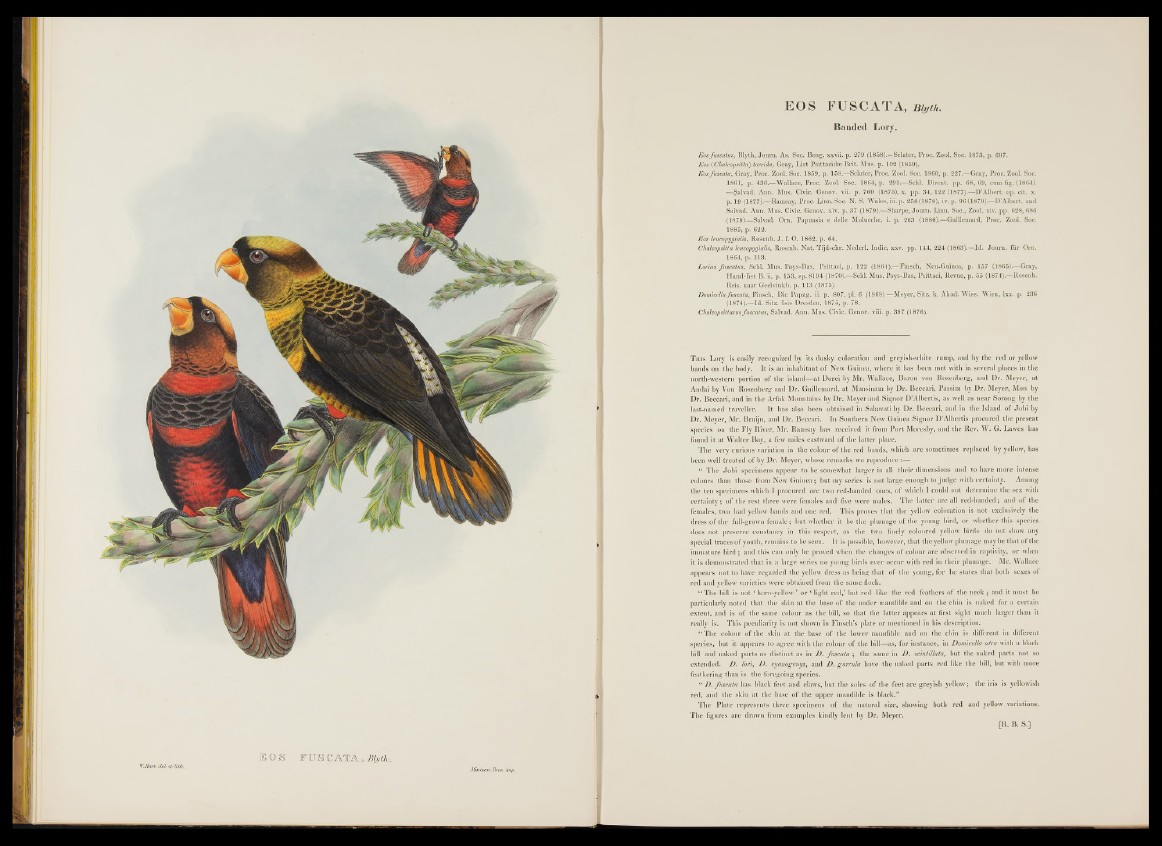
TV.Eart ¿UL et litfu.
E O S E U S C A T A , Ebyth
Muiterrv Bros. imp.
EOS FUSCATA, my th.
Banded Lory.
Eos fuscatus, Blyth, Journ. As. Soc. Beng. xxvii. p. 279 (1858).—Sclater, Proc. Zool. Soc. 1873, p. 697.
Eos (Chalcopsitta) torrida, Gray, List Psittacidse Brit. Mus. p. 102 (1859).
Eos fuscata, Gray, Proc. Zool. Soc. 1859, p. 158.—Sclater, Proc. Zool. Soc. 1860, p. 227.—Gray, Proc. Zool. Soc.
1861, p. 436.—Wallace, Proc. Zool. Soc. 1864, p. 291.—Schl. Dirent. pp. 68,69, cum fig. (1864).
—Salvad. Ann. Mus, Civic. Genov, vii. p. 760 (1875), x. pp. 34, 122 (1877).—D’Albert. op. cit. x.
p. 19 (1877).—-Ramsay, Proc. Linn. Soc. N. S. Wales, iii. p. 258(1878), iv. p. 96(1879).—D’Albert. and
Salvad. Ann. Mus. Civic. Genov, xiv. p. 37 (1879).—Sharpe, Journ. Liun. Soc., Zool. xiv. pp. 628, 686
(1879).—Salvad. Orn. Papuasia e delle Molucche, i. p. 263 (1880).—Guillemard, Proc. Zool. Soc.
1885, p. 622.
Eos leucopygialis, Rosenb. J. f. O. 1862, p. 64.
Chalcopsitta leucopygialis, Rosenb. Nat. Tijdschr. Nederl. Indie, xxv. pp. 144, 224 (1863).—Id. Journ. fur Orn.
1864, p.. 113.
Lorius fuscatus, Schl. Mus. Pays-Bas, Psittaci, p. 122 (1864).—Finsch, Neu-Guinea, p. 157 (1865).—Gray,
Hand-list B. ii. p. 153, sp. 8194 (1870).—Schl. Mus. Pays-Bas, Psittaci, Revue, p. 55 (1874).—Rosenb.
Reis, naar Geelvinkb. p. 113 (1875).
Domicella fuscata, Finsch, Die Papag. ii. p. 807, pi. 6 (1868) —Meyer, Sitz. k. Akad. Wiss. Wien, lxx. p. 236
(1874plf-Id. Sitz. Isis Dresden, 1875, p. 78.
Chalcopsittacus fuscatus, Salvad. Ann. Mus. Civic. Genov, viii. p. 397 (1876).
T h i s Lory is easily recognized by its dusky coloration and greyish-white rump, and by the red or yellow
hands on the body. I t is an inhabitant o f New Guinea, where it has been met with in several places in the
north-western portion o f the island— at Dorei by Mr. Wallace, Baron von Rosenberg, and Dr. Meyer, at
Andai by Von Rosenberg and Dr. Guillemard, a t Mansinam by Dr. Beccari, Passim by Dr. Meyer, Mon by
Dr. Beccari, and in the Arfak Mountains by D r. Meyer and Signor D’Albertis, as well as near Sorong by the
last-named traveller. I t has also been obtained in Salawati by Dr. Beccari, and in the Island o f Jobi by
Dr. Meyer, Mr. Bruijn, and Dr. Beccari. In Southern New Guinea Signor D’Albertis procured the present
species on the Fly River, Mr. Ramsay has received it from P o rt Moresby, and the Rev. W. G. Lawes has
found it at W alter Bay, a few miles eastward o f the latter place.
T h e very curious variation in the colour o f the red hands, which are sometimes replaced by yellow, has
been well treated o f by Dr. Meyer, whose remarks we reproduce
“ The Jo b i specimens appear to be somewhat larger in all their dimensions and to have more intense
colours than those from New Guinea; but my series is not large enough to judge with certainty. Among
the ten specimens which I procured are two red-banded ones, of which I could not determine the sex with
certainty; o f the rest three were females and five were males. T h e latter are all red-banded; and o f the
females, two bad yellow bands and one red. This proves that the yellow coloration is not exclusively the
dress o f the full-grown female; but whether it be the plumage o f the young bird, or whether this species
does not preserve constancy in this respect, as the two finely coloured yellow birds do not show any
special traces o f youth, remains to be seen. It is possible, however, th at the yellow plumage may be that o f the
immature b ird ; and this can only be proved when the changes o f colour are observed in captivity, or when
it is demonstrated th at in a large series no young birds ever occur with red in their plumage. Mr. Wallace
appears not to have regarded the yellow dress as being that of the young, for he states th at both sexes of
red and yellow varieties were obtained from the same flock.
“ The bill is not ‘ horn-yellow ’ or ‘ light r e d / but red like the red feathers o f the neck ; and it must be
particularly noted that the skin a t the base o f tbe under mandible and on the chin is naked for a certain
extent, and is o f the same colour as the bill, so th at the latter appears a t first sight much larger than it
really is. This peculiarity is not shown in Finsch’s plate o r mentioned in his description.
“ T h e colour o f the skin at the base o f the lower mandible and on the chin is different in different
species, but it appears to agree with the colour o f the bill—as, for instance, in Domicella atra with a black
bill and naked p arts as distinct as in D . fuscata ; the same in D . scintillata, but the naked parts not so
extended. D . lori, D . cyanogenys, and D . garrula have the naked p arts red like the bill, but with more
feathering than in the foregoing species.
“ D . fuscata has black feet and claws, but the soles o f the feet are greyish yellow; the iris is yellowish
red, and the skin a t the base o f the upper mandible is black.”
T h e Plate represents three specimens o f the natural size, showing both red and yellow variations.
The figures are drawn from examples kindly lent by Dr. Meyer.